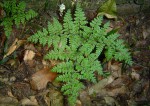Cheilanthes bergiana Schltdl.
Synonyms |
Hypolepis bergiana (Schltdl.) Hook. |
|---|---|
Common name |
|
Description |
Rhizome erect or shortly creeping, up to 10 mm in diameter, producing underground stolons that give rise to new plants at their tips; rhizome scales lanceolate in outline, margin (sub)entire, 4-9 x 0.7 mm, dark brown with pale brown margins. Fronds monomorphic, tufted, erect to arching, 30-100 cm long, herbaceous. Stipe up to 65 cm long, chestnut to dark brown, densely set with short, brown hairs and with narrow scales at the extreme base. Lamina 3-pinnate to 5-pinnatifid, roughly pentagonal to triangular in outline, lower pinnae basiscopically developed, 2/3-3/4 the length of the lamina, upper pinnae less divided, 11-45 × 10-50 cm; pinnules shortly petiolate, deltate-lanceolate in outline; ultimate segments oblong-lanceolate in outline, up to 4 x 2 mm, decurrent, rounded, venation free, both surfaces lightly set with short hairs up to 1 mm long; rhachis, costae and costules thinly pubescent. Sori marginal, small, less than 1 mm in diameter, discrete; indusium small, lunate, (sub)entire, membranous. |
Notes | Could be confused with C. multifida or C. pentagona, but these species are (sub)-glabrous, do not have underground stolons and do not occur in forests. |
Derivation | bergiana: named after C.H.Bergius (1790-1818), German collector in the Cape. |
Habitat | Wet forest floors and forest edges in intermediate to montane evergreen and mist forest, deep shade, often riverine or in grassy glades, also Cypress plantations, sometimes on dead logs. |
Distribution worldwide | Africa, Madagascar. |
Distribution in Africa |
Dem. Republic of Congo, Ethiopia, Kenya, Malawi, Mozambique, South Africa, Swaziland, Tanzania , Uganda, Zimbabwe. |
Growth form |
Terrestrial. |
Literature |
|

